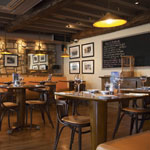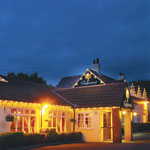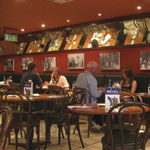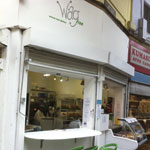Are you missing out on the gluten-free £?
Some one in 100 people suffer from coeliac disease, but, in the main, restaurants aren't geared up to cater for them. Eleanor Earls finds out why operators should be tapping into a market worth more than £100m
People with coeliac disease make up 1% of the UK population, but the vast majority are not eating out on a regular basis as they do not feel confident that restaurants are offering safe gluten-free food.
"When we calculated the size of the potential untapped market, taking into account the fact that coeliacs could be bringing two or three other people along with them to eat out, we discovered it was worth about £100m," says Sarah Sleet, CEO of Coeliac UK.
"What's more, sitting alongside the 600,000-strong coeliac population who suffer from a serious autoimmune condition, there seems to be a more general section of gluten-intolerant people, who are also going to be looking for gluten-free options. Times are tough for everyone so catering for a market that's completely untapped has got to be good business."
The market is only getting bigger. Indeed, Michael Wignall, head chef of the Michelin-starred Latymer restaurant at Pennyhill Park hotel in Surrey, says he's seen a 3-5% increase in the number of gluten-free guests in the past 12 months.
"In this day and age, you can't afford to ignore it any more. It's on the increase and people are becoming more demanding. They want value for money and quality; they don't want to be an afterthought," he says.
Yet the majority of restaurant operators still think of going gluten-free as a nightmare rather than an opportunity, cost being one of the main concerns. On this issue, Sleet is keen to point out that, although gluten-free options are more expensive for restaurants to purchase, coeliacs are generally willing to pay a bit more for the opportunity to feel comfortable when eating out.
Moreover, it's not that difficult to add gluten-free dishes to your menu, according to Chris Horridge, director of the 10 in 8 Group Fine Dining Academy and a renowned gluten-free food enthusiast.
"A lot of it's to do with education," he says. "There's actually a huge number of recipes where you can replace normal flour with gluten-free flour and there's no perceptible difference to the final product."
Charlie Lockley, head chef at Boath House hotel in the Scottish Highlands, who offers a six-course daily changing gluten-free menu, agrees.
"First of all it might be a bit of pain, but you soon get into the swing of it and realise what you can and can't do," he says.
"For us in the kitchen it's great because it keeps us learning all the time. Sometimes I even end up changing the regular menu to use rice flour or tapioca flour because it's worked in our favour. Obviously, it's great for trade too; guests know we've bent over backwards to please them and they come back again and again."
It's not all plain sailing, however, and issues such as cross-contamination have to be top priority at all times.
"There are probably quite a few options on your menu that are naturally gluten-free," says Sleet. "For these, it becomes about preparing your food to avoid cross-contamination. Of course it gets trickier with gluten-free pizza and pasta dishes. For these options, restaurants need to work out how to separate gluten-containing and gluten-free foods either by having different areas or by preparing at different times of day and having a thorough clean-down."
For Sleet, it is absolutely essential that restaurant staff are comprehensively educated on the consequences of getting it wrong. "We are very much working with the industry to ensure they have good induction procedures. Just as the catering business has to make sure hygiene is paramount, training issues with allergens need to become part of everyday working practice," she emphasises.
Over the past five years, supermarkets have embraced the growing demand for gluten-free food, some offering entire aisles of free-from products, but the hospitality is only just beginning to gear up.
"There has been a supply chain issue, but as caterers are responding to that, the number of suppliers is increasing," Sleet concludes. "We see new entrants into the market all the time, and operators are now able to get the quality products that they want."
A matter of marketing
"It's commercially driven as well because we pretty quickly worked out that we're not just getting one person's meal ticket; coeliacs will go out to eat with three or four other people."
For Whitehead, it's largely a matter of marketing, as many of the chain's dishes were naturally gluten-free. "With the ones that weren't, it wasn't too difficult to change," he notes. For example, the popular beef bourguignon was made with flour, which has now been replaced with a gluten-free alternative. "We've now got a better quality stock and it actually tastes better," he adds.
There's been a cost for the marketing campaign as well as an expense attached to putting something totally new to the menu, but overall Whitehead estimates that the new initiative will be worth around £10,000 to £20,000 per month across the chain.
CASE STUDY: HOW GLUTEN-FREE MENUS ARE ATTRACTING CUSTOMERS
Available alongside the usual lunch and a la carte choices, the gluten-free menus at the Copper Horse in Seamer, and its sister restaurant, the Tanglewood (pictured) near York, offer a mix of free-from starters, mains and desserts.
Its dedication to broadening its appeal has made the Tanglewood the first port of call when customer Negin Lankarani, who has a wheat intolerance, travels up from London to visit her parents in Scarborough.
"I always struggle to eat out - even in London - so I was over the moon when I discovered the Tanglewood had introduced a gluten-free menu. Now I visit every time I'm up there," she says.
The free-from dishes on the new menu include slow-braised lamb shank, hand-pressed steak mince burger served in a gluten-free bun, and a range of fresh fish cooked in gluten-free batter. But Lankarani's favourite dish is the oven-baked fish cakes. She adds: "The wheat-free roast dinners are also great - especially the wheat-free Yorkshire puddings."
Copper Horse manager Rob Lazenby explains: "A lot of people living with coeliac disease and wheat intolerance have given up on eating out after struggling to find anywhere that can cater for their needs. We've had an increasing number of customers asking us for gluten-free options and did a great deal of research to find out what we could serve them."
Tips for going gluten-free
â- Check what new products are available that you can use to amend your existing dishes. You might be surprised at what's available in terms of bread, pasta and pizza base products.
â- Change the way you make sauces. There are many alternatives to wheat flour to thicken sauces, such as potato starch or cornflour.
â- Educate your staff on the simple things: use different water for gluten-free and gluten-containing pasta; serve gluten-free bread in a different basket to regular bread; and store gluten-free products in separate areas.
â- Make sure your core market knows you are offering gluten-free food. Search out your local coeliac organisations and engage with them. They want to know about what you're doing.
â- Think outside the box and be adventurous. You might end up adding a gluten-free dish to your regular menu because it works so well.
Staying in touch with a massive market
"We were finding that there were more and more coeliacs out there. From a purely commercial point of view, there was clearly a massive market," he says.
"Moreover, if coeliacs see that a restaurant has gone the extra mile to try and adapt their menu, they are fiercely loyal, which is immeasurable in terms of significance to the business."
Dammone has even added gluten-free beer to the menu on the request of one regular punter. "It's a customer service thing we look at adopting anyway," he explains.
In terms of suppliers, it's a quickly growing market according to Dammone.
"There's no excuse for restaurants not to offer gluten-free pasta," he notes.
"There are some amazing quality pastas that I'm happy eating as a non-coeliac."
Although the cost of offering gluten-free pasta can be up to four times that of regular pasta, it certainly hasn't done Salvo's any harm in terms of revenue.
"In the last five years, we've doubled the size of our business," Dammone says.
"I don't put that down solely to the gluten-free products; it's just one of the many things one has to do to stay ahead of the game."
Preventing cross-contamination is the key
"I'd just been diagnosed coeliac. I'd researched the food I wanted to eat and found plenty of sweet things, but very few savoury," owner David Scrace says. The Wag Free Cafe, which serves freshly baked gluten-free food including pies, breads and burgers, was born.
After learning how to cook with gluten-free ingredients (pastries were particularly tough, according to Scrace), controlling cross-contamination has been the biggest challenge.
"If you're coeliac, you become very ill if you come into contact with wheat, rye, barley or gluten, so if you're preparing food for people of that ilk, there can be no compromise," he says.
Costs have been another issue. "Prices of products such as tapioca and potato flour are going up all the time," Scrace says, but it hasn't put him off his mission, as the customers just keep on coming.
"We've only been able to afford Facebook marketing, but people have still found us more than we've looked for people," he says. "We're very lucky; all we've got to do is announce we're here and the people will come."
How to avoid cross contamination
www.coeliac.org.uk/sites/files/coeliac/entire_toolkit_oct_2009.pdf
The charity is also looking to scale up its training programmes in this area due to the growing demand.










